|
Biblical
Archaeology regarding the Divided Kingdom of Israel and
Judah
God predicted the division of
Israel to Jeroboam through Ahijah the prophet.
-
Rehoboam’s unwillingness to reduce Solomon’s
heavy tax burden and conscription resulted in the
secession of the 10 northern tribes. They made Jeroboam
the first king, as Ahijah had predicted.
-
The Unified Kingdom of Israel was now split, with
the 10 tribes in the north, referred to as Israel, and
the tribes of Judah and Benjamin in the south, referred
to as Judah.
JEROBOAM (931-910)
1 Kings 12:25 – 14:20
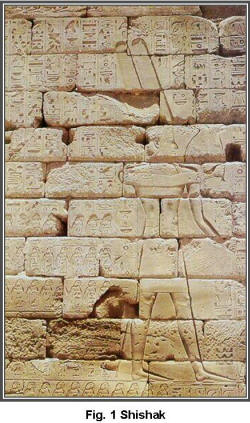 Jeroboam took over as first ruler
of the new 10-tribe nation of Israel. Jeroboam took over as first ruler
of the new 10-tribe nation of Israel.
-
The initial capital was established at Shechem
(1 Kings 12:25).
-
Jeroboam eventually established his permanent
capital at Tirzah (1 Kings
14:17; 15:21), thought to be modern Tell
el-Farah, about six miles northeast of Shechem.
Jeroboam sinned in the sight of God
by establishing cult worship for the people
(1 Kings 12:26-33). He
established worship centers at Dan in the north and
Bethel in the south. He erected gold calves at each
center.
-
God sent a messenger to rebuke Jeroboam. Called
“a man of God,” the messenger came north from
Judah, spoke against the Bethel altar, and predicted
that a prince of the House of David, Josiah, would one
day burn the bones of Jeroboam’s priests upon that very
altar. (1 Kings 13:1-3; 2
Kings 23: 15-16).
Jeroboam was not able to maintain
all of the land that he had received when he became
king.
-
The region around Damascus was lost. This is
known from the fact that, when Rezon (Damascus king)
died, he left Damascus as capital of an independent
Aramean state. Rezon was likely the Hezion of
1 Kings 15:18, who is
listed on the votive stele of Benhadad I.
o
The votive basalt stele of Benhadad I was
found in Bredsh, a village north of Aleppo.
-
Another area lost was in the southwest where the
Philistines reclaimed territory around Gibbethon.
-
In the east Moab was lost. The Moabite Stone
records her reconquest by Omri, Israel’s sixth king.
-
Jeroboam also suffered invasion into Israel by
Shishak (fig. 1), king of Egypt, who had earlier given
asylum to Jeroboam when he fled from Solomon.
o
The name of the Egyptian king to whom
Jeroboam fled, Pharaoh Shishak, has also been found on
an inscription, which lists the cities he conquered
during his invasion of Israel. This confirms the bible
in 1 Kings 14:25-26:
1KI 14:25
Now it happened in the fifth year of King Rehoboam, that
Shishak the king of Egypt came up against Jerusalem.
1KI
14:26
He took away the treasures of the house of the
LORD and
the treasures of the king’s house, and he took
everything, even taking all the shields of gold which
Solomon had made.
1 Kings
14:25-26 (NASB)
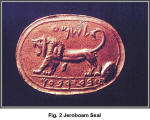 In 1903 during excavations at
Megiddo a jasper seal (fig. 2) was found with the
following inscription: In 1903 during excavations at
Megiddo a jasper seal (fig. 2) was found with the
following inscription:
-
“Shema servant of Jeroboam”
-
The seal belonged to a servant of either Jeroboam
I (first king of Israel), or Jeroboam II who ruled from
782-753 BC at the time of Jonah the prophet.
NADAB (910-909) –
1 Kings 15:25-31
Nadab succeeded his father,
reigning at Tirzah for two years. The only biblical
record we have is his siege of Gibbethon, in Philistine
territory, which his father lost.
-
During this siege Nadab was assassinated by
Baasha (1 Kings 15:27-28),
probably one of his generals, who then ruled.
BAASHA (909-886) –
1 Kings 15:32 – 16:7; 2
Chronicles 16:1-6
Baasha ruled for 24 years. Little
is recorded of his reign except that he continued in
conflict with Judah.
-
Baasha attempted to fortify Ramah, four miles
north of Jerusalem.
-
Asa, king of Judah, retaliated by persuading
Benhadad I (c. 896-874), king of the Aramean city of
Damascus, to attack Baasha’s northern cities. Benhadad
attacked and Baasha had to cease his efforts at Ramah to
protect his own land.
ELAH & ZIMRI (886-885)
– 1 Kings 16:8-22
Elah succeeded his father Baasha
and ruled two years.
-
Elah also wanted the Philistine city of Gibbethon
and sent his general, Omri, to lay siege to it. While
Omri was there, Zimri, another general, assassinated
Elah and proclaimed himself king.
-
When Omri, still at Gibbethon, learned of the
assassination he had himself declared king by his army
and returned to Tirzah where he successfully put down
Zimri’s rebellion.
OMRI (885-874) –
1 Kings 16:23-28
Omri began a dynasty that would
last three generations, but pressures from enemies were
ever present.
-
The Aramean state to the north was rising in
power. The Aramean king, Benhadad I, left a stele near
Aleppo which shows that he was able to extend his power
as far north as Syria by 850 BC.
-
In addition to the threat of Aramean, a greater
danger was rising in the east. Assyria was becoming a
world power under Ashur-nasir-pal II (883-859). With him
the period of Assyrian empire is said to have begun. He
marched his army across the Euphrates and occupied land
as far west as Byblos, Sidon, and Tyre on the
Mediterranean.
Omri was a strong ruler. Testimony
of this is provided by Assyrian rulers, living a century
later, who still referred to Israel as the “Land of
Omri.”
-
Adad-nirari III (810-782), Tiglath-pileser III
(745-727), and Sargon II (721-705) all make references
to Omri in various inscriptions and relief’s.
Omri built a new capital for
Israel, the city of Samaria, which would continue as
capital until Israel’s fall to the Assyrians in 722 BC.
-
Samaria proved to be an almost impregnable
stronghold. Excavation has revealed excellent
workmanship with walls some 24 feet thick.
-
Omri must have secured a Phoenician alliance as
implied by the marriage of his son Ahab to the
Phoenician princess, Jezebel. It is likely that he made
a treaty with her father, King Ethbaal.
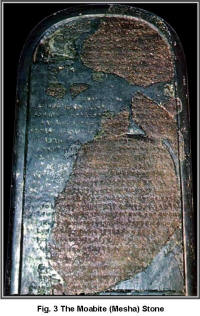 The Moabite (Mesha) Stone (fig.
3) The Moabite (Mesha) Stone (fig.
3)
This monument was found by a
German missionary in 1898, lying on the ground near the
Arnon River in the Biblical city of Dibon. Recorded on
the stone are victories over the Israelites by Mesha,
king of Moab
-
Written by Mesha, king of Moab
(2 Kings 3:4), it
states that “Omri, king of Israel” had conquered
Moab in the days of Mesha’s father. Mesha goes on to say
that under the direction of his god Chemosh he was able
to throw off the tribute that Omri had imposed.
-
What we are able to determine from the Moabite
Stone is that Omri was at some point capable of
defeating Moab.
The following is a translation of
the text taken from the Mesha stone:
Line 1 I Mesha, son of
Chemosh, Mesha’s king, the
Line 2 Dibonite. My
father governed Moab for 30 years, then I reigned
Line 3 after my father. I
made a high place for Chemosh in Qarhoh,
Line 5 As for Omri king
of Israel, he oppressed Moab for many years, for
Chemosh was furious with his
Line 6 country. And his
son followed in his footsteps, and he also said: “I will
cast down Moab.” In my days, he spoke,
Line 8 And he lived in it
during his time and in the days of his sons; 40 years;
yet Chemosh
Line 18 hearths of YHWH,
dragging them before Chemosh. And Israel’s king built
Line 31 [.....] sheep of
the land. While the house of David inhabited Horonaim.
Lines 1-3 mention King Mesha, a
Dibonite who ruled over Moab. He worshiped a Moabite god
called Chemosh, whom he attributes his victories to.
-
The Bible in 2 Kings
3:4 verifies Mesha was the king of Moab during
their revolt against Israel.
2KI 3:4
Now Mesha king of Moab was a sheep breeder, and used to
pay the king of Israel 100,000 lambs and the wool of
100,000 rams.
2 Kings 3:4
(NASB)
-
The bible also states in
Numbers 21:29-30, that
Dibon was a city in the land of Moab and mentions their
god, Chemosh.
NU 21:29
“ Woe to you, O Moab! You are ruined, O people of
Chemosh! He has given his sons as fugitives, And his
daughters into captivity, To an Amorite king, Sihon.
NU 21:30
“But we have cast them down, Heshbon is ruined as far as
Dibon, Then we have laid waste even to Nophah, Which
reaches to Medeba.”
Numbers
21:29-30 (NASB)
Lines 5-6 state that Omri was king
of Israel and that he was succeeded by his son.
-
The Bible confirms this in
1 Kings 16:23 & 28:
1KI 16:23
In the thirty-first year of Asa king of Judah, Omri
became king over Israel and reigned twelve years;
he reigned six years at Tirzah.
1KI 16:28
So Omri slept with his fathers and was buried in
Samaria; and Ahab his son became king in his place.
1 Kings
16:23, 28 (NASB)
Line 8 says that Omri and his sons
ruled for 40 years.
-
The Bible says the same thing starting in
1 Kings 16:23. Omri
ruled for 12 years, six of those years he co-reined with
Tibni, and for six years he ruled as king of Israel from
880-874 BC, his son Ahab took over and ruled 22 years
from 874-853 BC (1 Kings
16:29), then Ahab’s son Ahaziah ruled two years
from 853-852 BC (1 Kings
22:51), Ahab’s last son Joram ruled 10 years from
852-841 BC, a total of 40 years. Joram was killed by
Jehu in his eleventh year as king
(2 Kings 9:14-29).
Line 18 makes a reference to the
altar hearths of YHWH.
-
“YHWH” is the Hebrew word for God (Yahweh),
spelled just as it is used in the Bible.
Line 31 says, “And the House of
David inhabited Horonaim.”
-
Here is found one of the first references outside
of the bible to King David and his descendants, who were
from the tribe of Judah.
-
Mesha also makes a distinction between the men of
Israel and the House of David. This is exactly how the
Bible states Israel was divided as a kingdom during this
time.
-
Jehoshaphat was king of Judah from the House of
David, while Joram was the king of Israel (853 - 841),
according to 2 Kings 3.
-
The town of Horonaim is also mentioned in
Jeremiah 48:3-7.
AHAB (874-853) –
1 Kings 16:28-34; 20:1 – 22:40
King Ahab and Queen Jezebel did
evil in the sight of God more than all before them
(1 Kings 16:30). The
main reason for this accusation is that they introduced
Jezebel’s native religion, the cult of Baal to Israel.
-
Excavation at Samaria has revealed that Ahab
built an impressive casemate wall around the royal
quarter of the city. This was a double wall divided into
rooms by partitions. To the north the outer wall was
about six feet thick, the inner about four feet, and the
space between about 23 feet thick.
-
Archaeologists from Harvard digging at Samaria
have also found a palace that Ahab built which contained
within it a room where ivories were stored. This room is
mentioned in the bible in 1
Kings 22:39 which says:
1KI 22:39
Now the rest of the acts of Ahab and all that he did and
the ivory house which he built and all the cities which
he built, are they not written in the Book of the
Chronicles of the Kings of Israel?
1 Kings
22:39 (NASB)
-
God spoke against these houses in
Amos 3:15:
AM 3:15
“I will also smite the winter house together with the
summer house; The houses of ivory will also perish And
the great houses will come to an end,”
Declares
the LORD.
Amos 3:15
(NASB)
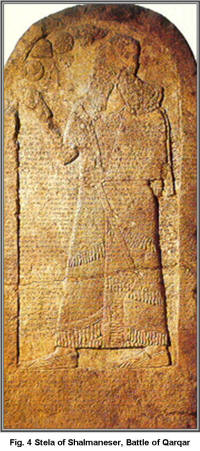 Ahab was an effective military
leader. Ahab was an effective military
leader.
-
On two occasions he defeated Aramean forces in
accordance with predictions of “a prophet” of God
(1 Kings 20:1-34). He
would have fought both Benhadad I and Benhadad II.
-
In 853 BC Ahab and Benhadad II (Aramean) joined
in a northern coalition to stop Shalmaneser’s (Assyria)
army at Qarqar on the Orontes River.
o
Ahab is mentioned in Assyrian records. In
an inscription that accounts a battle known as Qarqar
(fig. 4), between Ahab and King Shalmaneser III of
Assyria, Shalmaneser records the size of Ahab’s army
that fought against him. It mentions the following:
“2,000 chariots and 10,000 men of Ahab king of Israel.”
-
Ahab again fought with Benhadad II, this time at Ramoth-gilead (identified with Tell-Ramith, 28 miles
east of the Jordan and 15 miles south of the Sea of
Galilee) and was killed, thus fulfilling a prediction by
the prophet Micaiah (1 Kings
22: 13-39).
o
Jehoshaphat, king of Judah, had allied
himself with Ahab and was almost killed.
King Ahab married one of the most
wicked woman in scripture, Jezebel. Her father was known
as king Ethbaal, a dictator who took the throne of Sidon
by force. He did so by assassinating his brothers. His
name means, I am with Baal.
-
The Oriental Institute of Chicago, during
excavations near Samaria, found the ruins of a temple
built to Ashertoreth that stood during the reign of King
Ahab. Near the site were found jars that contained the
remains of infants who had been sacrificed in this
temple.
-
This find verifies that Baal & Asherah worship
were common in Samaria at the time of Jezebel.
1 Kings 18:19 mentions
that Jezebel surrounded herself with the prophets of
Baal and of Asherah.
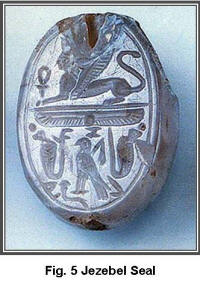 -
A seal has been found which once belonged to
Jezebel (fig. 5). The seal is inscribed with the letters
“JZBL”. According to the bible, Jezebel was quite
at home with sealing documents with a seal.
1 Kings 21:8 says: -
A seal has been found which once belonged to
Jezebel (fig. 5). The seal is inscribed with the letters
“JZBL”. According to the bible, Jezebel was quite
at home with sealing documents with a seal.
1 Kings 21:8 says:
1KI 21:8
So she wrote letters in Ahab’s name and sealed them with
his seal, and sent letters to the elders and to the
nobles who were living with Naboth in his city.
1 Kings
21:8 (NASB)
ELIJAH –
1 Kings 17-19; 21; 2 Kings 1:1
– 2:11
During the reign of Ahab, one of
Israel’s outstanding prophets ministered
(1 Kings 17-19; 21; 2 Kings
1:1-2:11). This was Elijah who came from Gilead
across the Jordan and dressed simply in camel’s hair
clothing. He demonstrated outstanding courage and faith
in opposing Jezebel’s introduction of the Baal cult.
AHAZIAH (853-852) –
2 Kings 1:2-18
Two sons of Ahab succeeded him:
first Ahaziah, then Jehoram. Ahaziah ruled only two
years and died without sons to succeed him, thus giving
opportunity for the second son, Jehoram. Ahaziah died
from wounds received in a fall. Two other matters from
his reign are recorded.
-
One is that Mesha, king of Moab, revolted against
the heavy tribute imposed by Jehoram’s grandfather,
Omri. Results of this uprising were experienced later in
Jehoram’s rule as well.
-
The other is that he entered into a joint
maritime venture with Jehoshaphat, king of Judah. The
ships built were all destroyed, even before their maiden
voyage. The destruction was in accordance with the
prophet Eliezer’s prediction, which pronounced God’s
displeasure at this second instance of Jehoshaphat
aligning himself with the wicked kings of Israel.
JEHORAM (852-841) -
2 Kings 3
Jehoram ruled longer than his
brother, a total of 12 years.
-
Moab’s king, Mesha, refused to send the tribute
imposed earlier by Omri. Jehoram took steps to force
continued tribute with the help of Jehoshaphat.
-
Mesha was able to save his country from
destruction through the sacrifice of his eldest son,
which affected the full withdrawal of Israel/Judah
forces. The exact connection between this sacrifice and
the withdrawal is not made clear, but it is possible
that the army of an apostate Israel feared the
intervention of Chemosh in response to this supreme
sacrifice.
-
The biblical account supports Mesha’s boast on
the Moabite Stone that deliverance from Israel’s
dominance was achieved in his day.
Contact between Israel and the
Arameans continued from the reign of Baasha through most
of Israel’s history. These particular contacts during
the rule of Jehoram were significant from the biblical
point of view because they involved the prophet Elisha.
-
There were many conflicts between Israel and Aram
of which Elisha provided assistance.
-
A final conflict with the Arameans led to
Jehoram’s death. Like Ahab his father, he met the
Arameans in battle at Ramoth-gilead with help in the
encounter from the king of Judah, Ahaziah. Jehoram was
seriously wounded and returned to Jezreel, alternate
capital of Omri rulers, to recover.
-
Later, Ahaziah, who had returned to Judah after
the battle came to Jezreel to visit him and ended up
being caught in a wave of destruction launched by Jehu,
which resulted in the death of both kings.
JEHU (841-814) -
2 Kings 9:11 - 10:36; 13;
14:16-29
Jehu killed Omri’s descendant’s, as
God had foretold through Elijah
(1 Kings 19:15-17; 21:21-24).
Elisha sent one of the “company of the prophets”
to anoint Jehu as king in Jehoram’s place and to
instruct him regarding the purging
(2 Kings 9:1-10). Jehu,
Jehoram’s military captain still at Ramoth-gilead,
accepted the honor and moved quickly across the Jordan
to Jezreel to carry out the instructions.
-
King Jehoram himself, still recovering from
wounds, was killed first.
-
Ahaziah, Judah’s king who was visiting, fled for
his life from Jezreel, but was later caught and killed
by pursuers sent by Jehu.
-
Jehu rode into Jezreel and ordered the attendants
of Jezebel to throw her from an upper window from which
she was looking. They readily complied, and dogs ate her
flesh as Elijah had predicted before
(1 Kings 21:23).
-
At Jehu’s insistence Ahab’s 70 sons were then
killed by Samaria’s leaders. Their heads were delivered
to Jehu at Jezreel.
-
After this Jehu left for Samaria, and on the way
met and killed 42 relatives of Ahaziah coming to visit
the two kings, not knowing they were already dead.
-
Jehu arrived at the capital and killed all the
officials there as well.
-
Lastly, Jehu called all the prophets and priests
of Baal to their temple in Samaria, as if to extend
favor to them, but then sent 80 of his men into the
temple to kill them to the last man.
-
This was a thorough blood purging.
Jehu experienced pressure from
foreign powers. This came mainly from the Arameans, led
by Hazael, in fulfillment of God’s prediction through
Elijah (1 Kings 19:15-17).
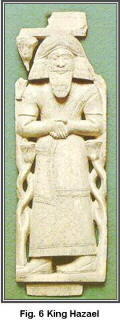 -
The fulfillment was first begun when Elisha went
north to Damascus to anoint Hazael (fig. 6) as the
Aramean king (2 Kings 8:7-15).
Elisha wept when he did so, he knew the havoc this man
would bring on Israel. -
The fulfillment was first begun when Elisha went
north to Damascus to anoint Hazael (fig. 6) as the
Aramean king (2 Kings 8:7-15).
Elisha wept when he did so, he knew the havoc this man
would bring on Israel.
1KI 19:15
The LORD
said to him, “Go, return on your way to the wilderness
of Damascus, and when you have arrived, you shall anoint
Hazael king over Aram;
1 Kings
19:15 (NASB)
-
Though there is no record of how Hazael brought
about this havoc, the extent of it is evidenced. He
succeeded in seizing all Transjordan from Israel,
including the tribal territories of Manasseh, Gad, and
Reuben (Amos 1:3).
Then, though it is not directly stated, he also must
have made serious inroads into Israel west of the
Jordan; for a notation from the time of Jehoahaz, son
of Jehu, states that Hazael by then was able to dictate
how many horses, chariots, and footmen Israel’s king
could have in his army (2
Kings 13:7).
-
This same Hazael is mentioned in Assyrian
records, evidenced by inscriptions from Shalmaneser III.
In one from his 14th year (845 BC), he
mentions Hadadezer (Benhadad II) as still king in
Damascus, and in another from his 18th year
(841) he mentions Hazael. This means that Hazael came to
the throne between 845 and 841. An inscription by
Shalmaneser III, known as the Black Obelisk states this:
“I fought against Benhadad and
take credit for his downfall. Hazael, the son of a
worthless man, then ascended to the throne.”
Israel also suffered at the hands
of Assyria during Jehu’s rule. In fact, the Assyrian
invasion came prior to that of Hazael, and brought even
greater harm to Hazael’s land than to Israel. The
occasion is known only from Assyrian records left by
Shalmaneser III.
-
Shalmaneser III was the same man against whom
Ahab and Benhadad had combined in a twelve-member
coalition at Qarqar a dozen years before. Now, for the
sixteenth time,
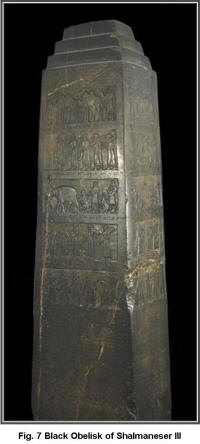 he crossed the Euphrates in military
campaign. he crossed the Euphrates in military
campaign.
-
He succeeded in leading his large army all the
way to Damascus, effecting damage on the city, though
without capturing it, and then went on to force Jehu in
Israel to pay heavy tribute. Shalmaneser also lists Tyre
and Sidon as paying tribute.
-
On his famous Black Obelisk (fig. 7) found at
Nimrud in 1846, Shalmaneser lists the tribute and
depicts the Israelite king bowing low in submission
while presenting his payment (fig. 8). Though
Shalmaneser does not claim to have wrought destruction
in Israel, the heavy tribute he demanded was
humiliating and economically oppressive. Shalmaneser
made one more attack in the general area three years
later claiming success once more, but nothing is known
of the details. No Assyrian army came again for a
generation, which permitted Hazael to regain the
strength to inflict the aforementioned harm on Israel.
o
The Black Obelisk is a four-sided
limestone pillar standing 6.5 feet high, with five rows
of relief’s and explanatory cuneiform inscriptions on
all sides. In the second row on one side appears Jehu.
The obelisk is in the British Museum.
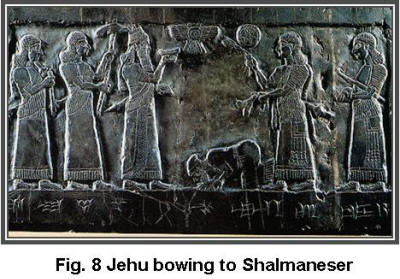
JEHOAHAZ (814-798) –
2 Kings 13:1-9
Jehoahaz succeeded Jehu his father
and reigned 17 years. Little is related regarding his
rule, apart from a further degree of subjection to
Hazael.
-
The only item stated is that he sought help from
God against Hazael and was given a “deliverer”
(2 Kings 13:5). This
“deliverer” must have been the Assyrian emperor,
Adad-nirari III (810-783), who came to the throne during
Jehoahaz’s reign. He did serve as “deliverer” to
Israel in that he attacked and crushed Damascus in 803
BC, thus bringing relief to Israel from the Aramean
oppression.
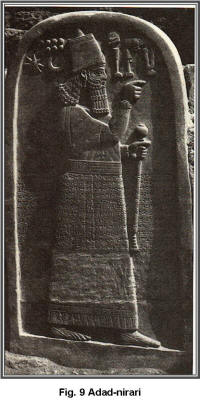 -
See the text left by Adad-nirari III (fig. 9). By
the time of this attack, Benhadad III, son and successor
of Hazael, had ascended the throne in Damascus. -
See the text left by Adad-nirari III (fig. 9). By
the time of this attack, Benhadad III, son and successor
of Hazael, had ascended the throne in Damascus.
JEHOASH (798-782) -
2 Kings 13:10-25; 14:15-16
At Jehoahaz’s death, his son
Jehoash assumed the throne. During his rule Israel took
steps toward recovery.
-
Soon after assuming office Jehoash was promised
victory over Damascus by Elisha.
-
Succeeding years saw Jehoash experiencing the
fulfillment of this prediction, enabling him to recover
all of the cities Damascus had taken earlier from Israel
(2 Kings 13:25).
-
Jehoash also became strong enough to withstand an
attack by Amaziah, king of Judah
(2 Kings 14:8-14).
-
Jehoash also appointed his son, Jeroboam II, as
co-ruler. Jeroboam II became coregent when Jehoash had
ruled only five of his 16 years.
JEROBOAM II (793-753)
- 2 Kings 14:23-29
Jeroboam II was the third
successive descendant of Jehu to occupy the throne, and
he proved to be one of Israel’s most capable rulers.
-
No description of Jeroboam’s battles in
accomplishing so much is given, but the end achievement
is clear: Jeroboam was able to establish roughly the
same boundaries on the east and north that had existed
in the empire days of David and Solomon. It is stated
that he placed Israel’s northern limit at the
“entering of Hamath” (2
Kings 14:25 KJV), the same phrase that describes
Solomon’s northern boundary (1
Kings 8:65).
-
It is also stated that “he recovered for
Israel both Damascus and Hamath” that had belonged
“to Judah” (2 Kings 14:28).
-
Still further, by gaining control over Damascus,
he must have also recovered all Transjordan, which Hazael had seized.
ZECHARIAH (753) -
2 Kings 15:8-12
Jeroboam’s son, Zechariah,
succeeded him, the fourth successive descendant of Jehu
to sit on the throne. He did not rule long, within six
months of assuming the throne he was assassinated by
his successor, Shallum.
-
Nothing else is indicated regarding Zechariah
except that he continued Jeroboam I’s false worship at
Dan and Bethel.
SHALLUM (752) -
2 Kings 15:13-15
Shallum killed Zechariah and set
himself up as ruler, thus instituting Israel’s sixth
ruling family. He reigned only one month, however, when
Menahem, possibly as military leader under Zechariah,
retaliated by killing him. Nothing further is recorded
regarding Shallum.
MENAHEM (752-742) -
2 Kings 15:16-22
Menahem now set himself up as
Israel’s ruler, thus instituting Israel’s seventh ruling
family. He ruled for a total of 10 years. During
Menahem’s rule, the power of Assyria was once again
exerted.
-
Tiglath-pileser III (745-727) had now come to the
throne and restored Assyria’s empire. He had achieved
success first to the south (in Babylonia) and also the
north (against the Urartu) before crossing the Euphrates
and coming west.
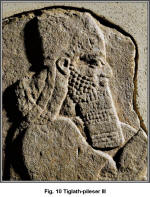 -
Tiglath-pileser III (fig. 10) was successful and
instituted policies that differed from those of previous
rulers. Former kings had been satisfied merely with
nominal control and a reception of tribute, but this
approach had resulted in constant revolt.
Tiglath-pileser III incorporated conquered land as
Assyrian provinces and deported native leaders who might
instigate revolution. -
Tiglath-pileser III (fig. 10) was successful and
instituted policies that differed from those of previous
rulers. Former kings had been satisfied merely with
nominal control and a reception of tribute, but this
approach had resulted in constant revolt.
Tiglath-pileser III incorporated conquered land as
Assyrian provinces and deported native leaders who might
instigate revolution.
-
His campaign of 743 BC reached all the way to
Israel and involved Menahem. Tiglath-pileser III was not
yet able to incorporate the area as a province, but he
did exact tribute from Menahem. In doing so Menahem
became a vassal to the Assyrian ruler
(2 Kings 15:19-20).
PEKAHIAH (742-740) & PEKAH
(752-732) - 2 Kings
15:23-31
At Menahem’s death his son
Pekahiah succeeded him. He ruled only two years when
Pekah, one of his military leaders, assassinated him at
the palace in Samaria and set himself up as king, thus
instituting Israel’s eighth ruling family.
-
In Pekah’s sixth year of sole rule, 734 BC,
Tiglath-pileser III returned to the west to put down
this rebellious alliance. He had come at the request of
Ahaz, king of Judah, who had been besieged in Jerusalem
by Pekah and Rezin (2 Chron.
28:5-8; Isa. 7:1-2). The two allies had hoped to
force Ahaz to join their rebellion. Instead, Ahaz asked
for aid from the Assyrian ruler.
-
Tiglath-pileser III complied by conducting his
campaigns of 734-732. He first moved down the
Mediterranean coast as far as Philistia and conquered
cities there, especially Gaza. Later he marched into
Israel destroying cities all across Galilee and taking
many people captive (2 Kings
15:29). In 732 he moved against Damascus,
capturing the capital city, and executing Rezin the
king. Tiglath-pileser III himself did not kill Pekah,
because Hoshea, who succeeded Pekah, did it for him.
o
All of these conquests are listed on
various inscriptions left by Tiglath-pileser III.
HOSHEA (732-722) -
2 Kings 17:1-6
Having slain Pekah, Hoshea assumed
rule, thus instituting Israel’s ninth and last royal
dynasty. The Bible records how Hoshea came to power in
2 Kings 15:29-30:
2KI 15:29
In the days of Pekah king of Israel, Tiglath-pileser
king of Assyria came and captured Ijon and
Abel-beth-maacah and Janoah and Kedesh and Hazor and
Gilead and Galilee, all the land of Naphtali; and he
carried them captive to Assyria.
2KI 15:30
And Hoshea the son of Elah made a conspiracy against
Pekah the son of Remaliah, and struck him and put him to
death and became king in his place, in the twentieth
year of Jotham the son of Uzziah.
2 Kings
15:29-30 (NASB)
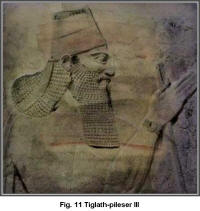
-
This event is confirmed in the annals of the king
of Assyria himself, Tiglath-Pileser III (fig. 11), whose
writings state the following concerning Hoshea:
“They had overthrown their king
Pekah, Hoshea I placed as ruler over them. From him I
received a tribute of 10 talents of gold and 1,000
talents of silver.”
-
The Assyrians had taken both the north (Galilee)
and Transjordan, incorporating these areas as Assyrian
provinces, leaving Hoshea only the hill country west
of the Jordan.
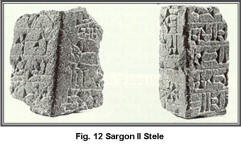 -
Hoshea himself was a vassal and soon turned in
revolt against the Assyrians. The revolt came after
Tiglath-pileser III was succeeded by his son
Shalmaneser V (727-722). -
Hoshea himself was a vassal and soon turned in
revolt against the Assyrians. The revolt came after
Tiglath-pileser III was succeeded by his son
Shalmaneser V (727-722).
-
Hoshea made a pact with Egypt, now weak, which
was unable to give the assistance Hoshea needed. Allied
with Egypt, Hosea refused to pay the required tribute to
Assyria.
-
In 724, Shalmaneser V marched on Israel
(2 Kings 17:3-6).
Hoshea went to meet him, now bringing his overdue
tribute, but this no longer satisfied the Assyrian king.
Hoshea was immediately taken captive and Shalmaneser
moved on to Samaria, placing the capital under siege.
The siege lasted from 724 to 722 with Samaria falling,
bringing the days of Israel as a sovereign nation to a
close.
-
The Bible states in 2
Kings 17:6:
2KI 17:6
In the ninth year of Hoshea, the king of Assyria
captured Samaria and carried Israel away into exile to
Assyria, and settled them in Halah and Habor, on
the river of Gozan, and in the cities of the Medes.
2 Kings
17:6 (NASB)
The captivity of Samaria is also recorded in Assyrian
records. During the siege of Samaria, Shalmaneser died
and Sargon II became king and continued the siege. An
inscription (fig. 12) of Sargon II states the following:
“In the first year of my reign I
captured Samaria along with 27,290 captives. The
foreigners of lands who had never paid me tribute, I
settled in Samaria.”
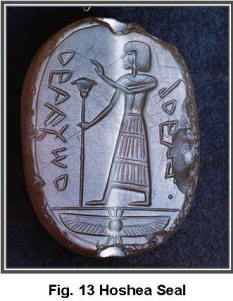 A seal bearing the name of King
Hoshea (fig. 13) has been found. It is inscribed with
the following words: “Abdi, Servant of Hoshea” A seal bearing the name of King
Hoshea (fig. 13) has been found. It is inscribed with
the following words: “Abdi, Servant of Hoshea”
-
The name of the owner of the seal was a man named
Abdi, which translated into English is Obadiah, meaning
“servant of Yahweh.” He must have served King
Hoshea in some fashion.
Israel under Assyria
After Samaria’s fall, an Assyrian
governor was placed over the land, thus incorporating
all of Israel into Assyria’s provincial system.
-
Many Israelites were taken captive by Assyria and
in place of these a foreign upper class of people was
imported. This manner of mixing populations had also
been instituted by Tiglath-pileser III as a means of
diminishing chances of rebellion among subjugated
peoples.
-
The foreigners brought with them their own native
ideas of deity and of worship. This influx resulted in a
religion, which both the false deities and God were
revered (2 Kings 17:29-41).
-
This mixing of population resulted also in
intermarriage between the Israelites who were left in
the land and the new foreign people. The descendants of
these marriages came to be called Samaritans.
Summary
Israel was a nation from 931 to 722
BC.
-
Nineteen kings ruled from nine different
families. Not one of the 19 was considered good by God,
because each followed either the substitute worship at
the golden-calf centers, or the more evil cult of Baal.
For this reason, God’s blessing was withheld.
-
Through Elijah and Elisha, warning was given to
the house of Omri concerning the excessive sin of
turning to Baal. When no heed was given, punishment was
issued, first in the destruction of the Omri family by
Jehu, and then in the humiliation of all Israel before
the Arameans of Damascus.
-
Once again warning came through Amos and Hosea to
the house of Jehu during the prosperous days of
Jeroboam II, for wickedness related to the material
affluence then existent. Nevertheless, again the people
would not hear. Thus, a second time God permitted major
humiliation in this instance at the hands of Assyria.
-
This occasion did not end until Samaria had
fallen and Israel ceased to exist as a sovereign power.
Israel had been given opportunity to repent, but would
not. God’s wrath fell upon her.
UZZIAH (790-739)
Uzziah was 16 years old when he
became king, and he reigned 52 years in Jerusalem.
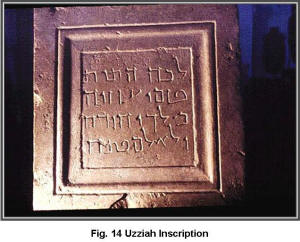 In 1931 in a Russian Orthodox
monastery located on the Mount of Olives, a first
century AD inscription was discovered bearing the name
of King Uzziah (fig. 14). The inscription reads:
“Here were brought the bones of Uzziah, King of Judah –
do not open.” In 1931 in a Russian Orthodox
monastery located on the Mount of Olives, a first
century AD inscription was discovered bearing the name
of King Uzziah (fig. 14). The inscription reads:
“Here were brought the bones of Uzziah, King of Judah –
do not open.”
-
Uzziah was a leper so he was not buried
with the other kings, but “near them in a field for
burial that belonged to the kings, for people said, ‘he
had leprosy’” (2 Chr
26:23).
Other artifacts that testify to
Uzziah’s existence are two seals (fig. 15).
-
One says: “Abyaw, steward of Uzziah”
-
The other says: “Shebnayahu, official to
Uzziah”
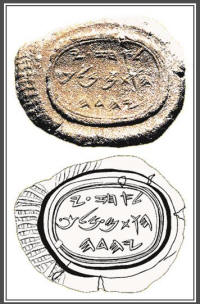
Another inscription, from the
Assyrian king Tiglath-Pileser, says “Azariah (Uzziah)
of Judah” four times.
AHAZ (743-715)
Two clay seals have been found with
the name of King Ahaz.
-
The first seal, which is located in the Yale
University library, reads: “Ushna, an attendant of
Ahaz.”
-
The second seal is reddish brown in appearance
and may contain the actual fingerprint of King Ahaz
impressed into its upper left edge. The seal reads:
“Ahaz (son of) Jotham, Judah’s king.” Not only is
Ahaz mentioned on this seal, but Ahaz’s father, King
Jotham is also listed.
Another mention of Ahaz that has
been found is taken from an inscription of
Tiglath-Pileser III in accounts from his battles against
Israel, between 744 and 727 BC, he records the
following: “From these I received tribute . . . Ahaz,
the king of Judah . . . including gold, silver, iron,
fine cloth and many garments made from wool that was
dyed in purple.”
-
This confirms 2 Kings
16:8 which states:
2KI 16:8
Ahaz took the silver and gold that was found in the
house of the LORD
and in the treasuries of the king’s house, and
sent a present to the king of Assyria.
2 Kings
16:8 (NASB)
HEZEKIAH (728-686)
During the time of Hezekiah was the
invasion of Judah by Sennacherib king of Assyria, who
eventually laid siege to Jerusalem.
-
These events are not only recorded in the Bible,
but they are also found in Sennacherib’s account of his
invasion of Judah, which was found on a clay prism (fig.
16) now on display at the Oriental Institute Museum of
Chicago. It is inscribed with the following words:
“Fear of my greatness terrified Hezekiah. He sent to me
tribute: 30 talents of gold, 800 talents of silver,
precious stones, ivory, and all sorts of gifts,
including women from his palace.”
-
This confirms the account given in
2 Kings 18:13-15:
2KI 18:13
Now in the fourteenth year of King Hezekiah, Sennacherib
king of Assyria came up against all the fortified cities
of Judah and seized them.
2KI 18:14
Then Hezekiah king of Judah sent to the king of Assyria
at Lachish, saying, “ I have done wrong. Withdraw from
me; whatever you impose on me I will bear.” So the king
of Assyria required of Hezekiah king of Judah three
hundred talents of silver and thirty talents of gold.
2KI 18:15
Hezekiah gave him all the silver which was found
in the house of the
LORD, and
in the treasuries of the king’s house.
2 Kings
18:13-15 (NASB)
-
Also found on Sennacherib’s prism, he says this
of Hezekiah: “As for the king of Judah, Hezekiah, who
had not submitted to my authority, I besieged and
captured forty-six of his fortified cities, along with
many smaller towns, taken in battle with my battering
rams . . . I took as plunder 200,150 people, both small
and great, male and female, along with a great number of
animals including horses, mules, donkeys, camels, oxen,
and sheep. As for Hezekiah, I shut him up like a caged
bird in his royal city of Jerusalem. I then constructed
a series of fortresses around him, and I did not allow
anyone to come out of the city gates. His towns which I
captured I gave to the kings of Ashod, Ekron, and Gaza.”
-
Sennacherib admits he never captured Hezekiah, or
the city of Jerusalem.
Why couldn’t the king of Assyria capture Jerusalem as he
did with all the other cities of Israel? The answer is
given in 2 Kings 19:14-37:
And
Hezekiah received the letter from the hand of the
messengers, and read it; and Hezekiah went up to the
house of the LORD, and spread it before the LORD. Then
Hezekiah prayed before the LORD, and said: “O LORD God
of Israel, the One who dwells between the cherubim, You
are God, You alone, of all the kingdoms of the earth.
You have made heaven and earth. Incline Your ear, O
LORD, and hear; open Your eyes, O LORD, and see; and
hear the words of Sennacherib which he has sent to
reproach the living God. Truly, LORD, the kings of
Assyria have laid waste the nations and their lands, and
have cast their gods into the fire; for they were not
gods, but the work of men’s hands; wood and stone.
Therefore they destroyed them. Now therefore, O LORD our
God, I pray, save us from his hand, that all the
kingdoms of the earth may know that You are the LORD
God, You alone.” Then Isaiah the son of Amoz sent to
Hezekiah, saying, “Thus says the LORD God of Israel:
‘Because you have prayed to Me against Sennacherib king
of Assyria, I have heard.’ This is the word which the
LORD has spoken concerning him…Whom have you reproached
and blasphemed? Against whom have you raised your voice,
And lifted up your eyes on high? Against the Holy One of
Israel. By your messengers you have reproached the
Lord,....Because your rage against Me and your tumult
Have come up to My ears, Therefore I will put My hook in
your nose And My bridle in your lips, And I will turn
you back By the way which you came.....Therefore thus
says the LORD concerning the king of Assyria: ‘He shall
not come into this city, Nor shoot an arrow there, Nor
come before it with shield, Nor build a siege mound
against it. By the way that he came, By the same shall
he return; And he shall not come into this city,’ Says
the LORD. ‘For I will defend this city, to save it For
My own sake and for My servant David’s sake.’” And it
came to pass on a certain night that the angel of the
LORD went out, and killed in the camp of the Assyrians
one hundred and eighty-five thousand; and when people
arose early in the morning, there were the corpses; all
dead. So Sennacherib king of Assyria departed and went
away, returned home, and remained at Nineveh. Now it
came to pass, as he was worshiping in the temple of
Nisroch his god that his sons Adrammelech and Sharezer
struck him down with the sword; and they escaped into
the land of Ararat. Then Esarhaddon his son reigned in
his place.”
-
Sennacherib’s death is also recorded on an
Assyrian inscription, which reads: “On the 20th day
of Tebet, his sons revolted against him and they killed
their father, Sennacherib. On the 18th day of Sivan,
Esarhaddon, his son, became king.”
The Pool of Siloam
The pool of Siloam was originally
constructed by King Hezekiah as recorded in
2 Kings 20:20:
2KI 20:20
Now the rest of the acts of Hezekiah and all his might,
and how he made the pool and the conduit and brought
water into the city, are they not written in the Book of
the Chronicles of the Kings of Judah?
2 Kings
20:20 (NASB)
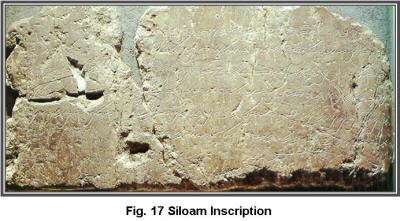
-
In John chapter 9 it is recorded that
Jesus healed a man who had been blind from birth at the
pool of Siloam.
-
An inscription was discovered in 1880 at
the sight of the pool of Siloam describing how two teams
of Jewish tunnelers digging towards one another, finally
met to finish the construction of the tunnel. The
discovery is known as the Siloam inscription (fig. 17)
and can be found at the Istanbul Archaeological Museum
in Turkey.
-
The inscription reads: “The account of
breakthrough is as follows. While the tunnelers were
working with their picks, each toward the other, and
while there was still 5 feet of rock to go through, the
rock split to the south and to the north, and the voices
of each were heard calling one to another. And at that
moment the laborers broke through striking pick against
pick. Then the water began to flow from the spring to
the pool for a distance of 1,900 feet. And the height of
the tunnel above the heads of the laborers was 160
feet.”
JOSIAH (642-609)
According to the bible, when King
Josiah was 26 years old, he ordered that the temple of
the Lord be repaired. In order to pay for the work, he
sent Shaphan his scribe to instruct Hilkiah the high
priest to collect money from the temple to pay for the
repairs (2 Kings 22:3-5).
-
A seal has been found by archaeologists bearing
the name of one of Hilkiah and one of his sons. The seal
reads: “Azariah son of Hilkiah.”
JEREMIAH (627-?)
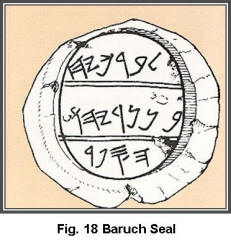 In 1975, nearly 250 clay seals were
found about 44 miles southwest of Jerusalem. These small
lumps of clay that are impressed with a seal, in ancient
times served as an official signature for an individual.
The clay seals were then attached to documents to
identify the sender. Among the seals that were found
were the names of four Biblical figures mentioned in
Jeremiah chapter 36. In 1975, nearly 250 clay seals were
found about 44 miles southwest of Jerusalem. These small
lumps of clay that are impressed with a seal, in ancient
times served as an official signature for an individual.
The clay seals were then attached to documents to
identify the sender. Among the seals that were found
were the names of four Biblical figures mentioned in
Jeremiah chapter 36.
-
The first clay seal is impressed with the
following inscription: “Berekhyahu son of Neriyahu
the scribe.” This is the seal of Baruch son of
Neriah who was the scribe to the prophet Jeremiah (fig.
18). Baruch’s full name must have been Berekhyahu. The
suffix (yahu) in the ancient Hebrew language is a form
of Yahweh (God). The name Baruch means “the blessed.”
Berekhyahu means “the blessed of Yahweh.” He
is mentioned in Jeremiah 36:1-4:
JER 36:1
In the fourth year of Jehoiakim the son of Josiah, king
of Judah, this word came to Jeremiah from the
LORD,
saying,
JER 36:2
“Take a scroll and write on it all the words which I
have spoken to you concerning Israel and concerning
Judah, and concerning all the nations, from the day I
first spoke to you, from the days of Josiah, even to
this day.
JER 36:3
“ Perhaps the house of Judah will hear all the calamity
which I plan to bring on them, in order that every man
will turn from his evil way; then I will forgive their
iniquity and their sin.”
JER 36:4
Then Jeremiah called Baruch the son of Neriah, and
Baruch wrote on a scroll at the dictation of Jeremiah
all the words of the
LORD which
He had spoken to him.
Jeremiah
36:1-4 (NASB)
-
A second clay seal has been found that was
impressed with the name of the scribe Elishama. It reads
as follows: “Elishama servant of the king.”
According to the Bible, Elishama was a scribe who served
the king. He is recorded in
Jeremiah 36:10-12:
JER 36:10
Then Baruch read from the book the words of Jeremiah in
the house of the
LORD in the chamber of Gemariah the son of
Shaphan the scribe, in the upper court, at the entry of
the New Gate of the
LORD'S
house, to all the people.
JER 36:11
Now when Micaiah the son of Gemariah, the son of
Shaphan, had heard all the words of the
LORD from
the book,
JER 36:12
he went down to the king’s house, into the scribe’s
chamber. And behold, all the officials were sitting
there— Elishama the scribe, and Delaiah the son of
Shemaiah, and Elnathan the son of Achbor, and Gemariah
the son of Shaphan, and Zedekiah the son of Hananiah,
and all the other officials.
Jeremiah
36:10-12 (NASB)
-
The previous passage also mentions another
scribe, Gemariah the son of Shaphan. His clay seal has
also been found. The inscription reads: “Gemariah,
son of Shaphan”
-
The fourth clay seal that was found is inscribed
with the name of king Jehoiakim’s son, Jerahmeel. It
reads as follows: “Yerahme’el, son of the king.”
He is recorded in
Jeremiah
36:26.
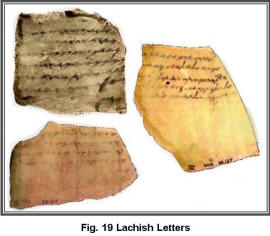 In 1935, a collection of letters
written on pottery was unearthed in the biblical city of
Lachish (fig. 19). These letters confirm events that
occurred during King Zedekiah’s reign. The letters also
mention the names of biblical figures, possibly even the
prophet Jeremiah. In 1935, a collection of letters
written on pottery was unearthed in the biblical city of
Lachish (fig. 19). These letters confirm events that
occurred during King Zedekiah’s reign. The letters also
mention the names of biblical figures, possibly even the
prophet Jeremiah.
-
The letters were written around 588 BC when
Nebuchadnezzar king of Babylon was waging war against
Jerusalem and the fortified cities that Judah used for
defense.
-
Letter number 1 is nothing more then a list of
names, but five of them may refer to biblical figures.
o
The first name listed is Gemariah. There
are two Gemariah’s listed in the bible during this time
frame. The first is Gemariah son of Hilkiah who is
mentioned in Jeremiah 29:3.
The second is Gemariah son of Shaphan who is mentioned
in Jeremiah 36:10.
o
Another name on the list is Jaazaniah, one
of the Judean military officers mentioned in
2 Kings 25:23. A seal
has also been found bearing the name Jaazaniah. It is
inscribed: “Yaazenyahu (Jaazaniah), Servant of the
King.”
o
The third name found in the Lachish letter
is Neriah, he was the father of Jeremiah’s scribe,
Baruch, mentioned in Jeremiah
36:4, as well as Seriah who is mentioned in
Jeremiah 51:59.
Seraiah’s seal has also been found, it is inscribed with
the following words: “Seriahu, son of Neriahu”
o
The fourth name is Mattaniah, who
according to the bible was appointed King of Judea by
Nebuchadnezzar, who changed his original Hebrew name to
Zedekiah, recorded in 2 Kings
24:17.
o
The fifth biblical name on the list is
Jeremiah, and may possibly refer to the prophet Jeremiah
himself.
-
Another pottery fragment known as letter IV is
inscribed with the following words: “I will send for
him tomorrow at daylight. And let it be known to my
master that we will be looking for the signals from
Lachish, according to the instructions which he has
given, for no signals from Azekah have been seen.”
Lachish and Azekah were two of Judah’s fortresses first
mentioned in 2 Chronicles
11:5-12:
“So
Rehoboam dwelt in Jerusalem, and built cities for
defense in Judah. And he built Bethlehem, ..... Lachish,
Azekah, Zorah, Aijalon, and Hebron, which are in Judah
and Benjamin, fortified cities. And he fortified the
strongholds, and put captains in them, and stores of
food, oil, and wine. Also in every city he put shields
and spears, and made them very strong, having Judah and
Benjamin on his side.”
-
The Lachish letters were written by the commander
of Lachish who was under siege. Letter IV seems to
indicate that the city of Azekah had fallen. This
historic event confirms the biblical account found in
Jeremiah 34:6-7 which
says:
“Then
Jeremiah the prophet spoke all these words to Zedekiah
king of Judah in Jerusalem, when the king of Babylon’s
army fought against Jerusalem and all the cities of
Judah that were left, against Lachish and Azekah; for
only these fortified cities remained of the cities of
Judah.”
Another pottery fragment found at
Lachish had the following inscription written on it,
which mentions two biblical figures: “The commander
of the army, Coniah son of Elnathan, has arrived and
will shortly leave for Egypt.” ....”And as for the
letter from the servant of the king, Tobiah, which came
to Shallum son of Jaddu’a through the prophet, saying
‘Be on your guard!’, your subject has sent it to my
lord.”
-
The first biblical name found in Letter III is
Elnathan. There are references to two men named Elnathan
in the bible during this time frame; the first being
Elnathan of Jerusalem who was the grandfather of king
Jehoiachin, father in law to king Jehoiakim. He is found
in 2 Kings 24:8-17:
“Jehoiachin
was eighteen years old when he became king, and he
reigned in Jerusalem three months. His mother’s name was
Nehushta the daughter of Elnathan of Jerusalem.....At
that time the servants of Nebuchadnezzar king of Babylon
came up against Jerusalem, and the city was besieged.
And he carried Jehoiachin captive to Babylon.... Then
the king of Babylon made Mattaniah, Jehoiachin’s uncle,
king in his place, and changed his name to Zedekiah.”
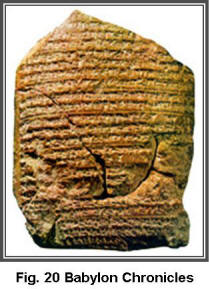 o
The appointment of Zedekiah as king over
Judah as mentioned in the preceding passage has also
been found in records from Babylon known as the
Babylonian Chronicles (fig. 20). The tablet records that
after Jerusalem was captured by Nebuchadnezzar in 597
BC, “He installed a king of his own choosing.”
(Zedekiah). o
The appointment of Zedekiah as king over
Judah as mentioned in the preceding passage has also
been found in records from Babylon known as the
Babylonian Chronicles (fig. 20). The tablet records that
after Jerusalem was captured by Nebuchadnezzar in 597
BC, “He installed a king of his own choosing.”
(Zedekiah).
-
The second Elnathan found in the bible is
Elnathan son of Achbor, who was a prince in king
Jehoiakim’s household. He is mentioned in
Jeremiah 26:22 and Jeremiah
36:12.
-
In the second part of letter III is an
astonishing statement about a letter, which came to
Shallum son of Jaddu’a through the Prophet. Since there
was only one major prophet at the time the Lachish
letter was written, it seems very likely that this is a
reference to the prophet Jeremiah.
JEHOIACHIN (597)
According to the bible, Jehoiachin
became king of Judah after the death of his father King
Jehoiakim:
2CH 36:9
Jehoiachin was eight years old when he became king, and
he reigned three months and ten days in Jerusalem, and
he did evil in the sight of the
LORD.
2
Chronicles 36:9 (NASB)
-
The first archaeological evidence for his reign
as king comes from inscriptions discovered in Israel
bearing the words: “Eliakim officer Yaukin”
-
The words were found stamped on three pottery jar
handles. Yaukin is the Aramaic name for Jehoiachin.
Evidently these jars once belonged to one of
Jehoiachin’s servants.
Another discovery that verifies
biblical events surrounding Jehoiachin’s life was found
in Babylon.
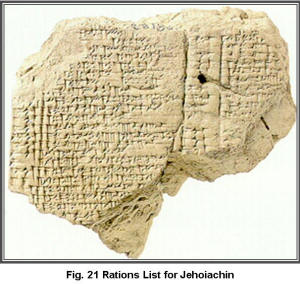 -
Tablets from the royal archives of Nebuchadnezzar
king of Babylon were unearthed in the ruins of that
ancient city that contain food rations paid to captives
and craftsmen who lived in and around the city. On one
of the tablets, “Yaukin, king of the land of Judah”
is mentioned along with his five sons listed as royal
princes. Below are a few inscriptions found on the
tablets (fig. 21): -
Tablets from the royal archives of Nebuchadnezzar
king of Babylon were unearthed in the ruins of that
ancient city that contain food rations paid to captives
and craftsmen who lived in and around the city. On one
of the tablets, “Yaukin, king of the land of Judah”
is mentioned along with his five sons listed as royal
princes. Below are a few inscriptions found on the
tablets (fig. 21):
10 (sila of oil) to the king of
Judah, Yaukin.
2 1/2 sila (oil) to the
offspring of Judah’s king,
10 sila to Iakuukinu, the king
of Judah’s son,
2 1/2 sila for the five sons of
the Judean king
-
This evidence matches precisely with the biblical
text found in 2 Kings 24:10-17
which says:
”At that
time the servants of Nebuchadnezzar king of Babylon came
up against Jerusalem, and the city was besieged. And
Nebuchadnezzar king of Babylon came against the city, as
his servants were besieging it. Then Jehoiachin king of
Judah, his mother, his servants, his princes, and his
officers went out to the king of Babylon; and the king
of Babylon, in the eighth year of his reign, took him
prisoner. And he carried out from there all the
treasures of the house of the LORD and the treasures of
the king’s house, and he cut in pieces all the articles
of gold which Solomon king of Israel had made in the
temple of the LORD, as the LORD had said. Also he
carried into captivity all Jerusalem: all the captains
and all the mighty men of valor, ten thousand captives,
and all the craftsmen and smiths. None remained except
the poorest people of the land. And he carried
Jehoiachin captive to Babylon. The king’s mother, the
king’s wives, his officers, and the mighty of the land
he carried into captivity from Jerusalem to Babylon. All
the valiant men, seven thousand, and craftsmen and
smiths, one thousand, all who were strong and fit for
war, these the king of Babylon brought captive to
Babylon. Then the king of Babylon made Mattaniah,
Jehoiachin’s uncle, king in his place, and changed his
name to Zedekiah.”
-
Archaeology thus indicates that Jehoiachin was
treated well by the kings of Babylon whom provided daily
food rations for him. This corresponds with the
scripture found in 2 Kings
25:27-30:
“Now it
came to pass in the thirty-seventh year of the captivity
of Jehoiachin king of Judah, in the twelfth month, on
the twenty-seventh day of the month, that Evil-Merodach
king of Babylon, in the year that he began to reign,
released Jehoiachin king of Judah from prison. ‘He spoke
kindly to him, and gave him a more prominent seat than
those of the kings who were with him in Babylon. So
Jehoiachin changed from his prison garments, and he ate
bread regularly before the king all the days of his
life. And as for his provisions, there was a regular
ration given him by the king, a portion for each day,
all the days of his life.”
|


 Jeroboam took over as first ruler
of the new 10-tribe nation of Israel.
Jeroboam took over as first ruler
of the new 10-tribe nation of Israel. In 1903 during excavations at
Megiddo a jasper seal (fig. 2) was found with the
following inscription:
In 1903 during excavations at
Megiddo a jasper seal (fig. 2) was found with the
following inscription: The Moabite (Mesha) Stone (fig.
3)
The Moabite (Mesha) Stone (fig.
3) Ahab was an effective military
leader.
Ahab was an effective military
leader. -
- -
- he crossed the Euphrates in military
campaign.
he crossed the Euphrates in military
campaign.
 -
- -
-
 -
- A seal bearing the name of King
Hoshea (fig. 13) has been found. It is inscribed with
the following words: “Abdi, Servant of Hoshea”
A seal bearing the name of King
Hoshea (fig. 13) has been found. It is inscribed with
the following words: “Abdi, Servant of Hoshea” In 1931 in a Russian Orthodox
monastery located on the Mount of Olives, a first
century AD inscription was discovered bearing the name
of King Uzziah (fig. 14). The inscription reads:
“Here were brought the bones of Uzziah, King of Judah –
do not open.”
In 1931 in a Russian Orthodox
monastery located on the Mount of Olives, a first
century AD inscription was discovered bearing the name
of King Uzziah (fig. 14). The inscription reads:
“Here were brought the bones of Uzziah, King of Judah –
do not open.”

 In 1975, nearly 250 clay seals were
found about 44 miles southwest of Jerusalem. These small
lumps of clay that are impressed with a seal, in ancient
times served as an official signature for an individual.
The clay seals were then attached to documents to
identify the sender. Among the seals that were found
were the names of four Biblical figures mentioned in
Jeremiah chapter 36.
In 1975, nearly 250 clay seals were
found about 44 miles southwest of Jerusalem. These small
lumps of clay that are impressed with a seal, in ancient
times served as an official signature for an individual.
The clay seals were then attached to documents to
identify the sender. Among the seals that were found
were the names of four Biblical figures mentioned in
Jeremiah chapter 36. In 1935, a collection of letters
written on pottery was unearthed in the biblical city of
Lachish (fig. 19). These letters confirm events that
occurred during King Zedekiah’s reign. The letters also
mention the names of biblical figures, possibly even the
prophet Jeremiah.
In 1935, a collection of letters
written on pottery was unearthed in the biblical city of
Lachish (fig. 19). These letters confirm events that
occurred during King Zedekiah’s reign. The letters also
mention the names of biblical figures, possibly even the
prophet Jeremiah. o
o -
-